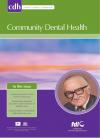Community Dental Health

- Cover Date:
- December 2006
- Print ISSN:
- 0265 539X
- Vol:
- 23
- Issue:
- 4
Abstracts
Abstracts
Papers presented at the BASCD Spring Presidential meeting in Cambridge, UK, March 2006
Salaried Primary Dental Care Services: A Vision
Janet Clarke, Chair of Central Committee for Community and Public Health Dentistry, British Dental Association. Objective To consider current legislative and policy changes in England that directly affect the Salaried Primary Dental Care Services (SPDCS) and explore the impact of these on the service after April 1st 2006. Issues The ï¬nal outcome of the review of SPDCS - Creating the Future, set out proposals to modernise career structures for salaried dentists. The Acting Chief Dental Ofï¬cer has also conï¬rmed that NHS Employers will be negotiating a new payscale for non specialists in the service. The Department of Health has just issued a Factsheet on commissioning SPDCS after April 1st 2006 and Directions are awaited. Impact Salaried services in England will either be new Personal Dental Services or Primary Care Trust Dental Services from 1st April. All services will operate in the same way as the General Dental Service (Performers Lists, dental charges, use of FP17 and collecting Units of Dental Activity). Conclusion Services might have both specialist lead teams (for example providing Special Care Dentistry) and generalists teams (providing general dentistry). Services need clear and detailed service level agreements or contracts to describe and protect the valuable work they currently do.
Specialisation and Specialist Lists: Implications for the Primary Secondary Care Interface
John Lowry, Chairman Standing Dental Advisory Committee, Oral & Maxillofacial Surgery, Royal Bolton Hospital, Bolton, UK Specialisation in dentistry evolved within both acute general and dental teaching hospitals with major advances resulting from experience gained in the management of the casualties of armed conflict. The establishment of the NHS in 1948 saw consultant dental surgeons appointed in parity with medical colleagues; an essential pre-requisite being the Fellowship in Dental Surgery denoting equality of training. Consultant work in general hospitals although predominantly surgical included a diagnostic and advisory service in any branch of dentistry where the treatment required the ‘skill, knowledge and facilities ‘ not available to the general dental practitioner. Consultant appointments in non-surgical dental specialties formerly conï¬ned to dental teaching hospitals progressively emerged initially in orthodontics and restorative dentistry. However practitioners in the primary care setting continued to provide specialised services and the vision of senior colleagues including Professor Sir Paul Bramley and later Dame Margaret Seward provided the catalyst for the formal establishment of a range of specialties by the General Dental Council. This together with more recent administrative changes has resulted in a number of innovative models for the delivery of specialist services and the aim should be to build on these with more cohesive working for the beneï¬t of our patients.
Specialisation in Special Care Dentistry
Janice Fiske, Guy’s, King’s and St Thomas’ Hospital, London, UK This presentation outlined what Special Care Dentistry (SCD) is; why a Specialty is needed; and what the current situation is. SCD describes the oral health care requirements and delivery of treatment for people with impairment, disability and/or complex medical conditions. There are 10 million people in the UK with disability/long-term illness that limits daily activities. For many reasons disability is increasing. Whilst the ethos of SCD has always been directed towards reducing health inequalities, the oral health of people with disability remains poorer than in the general population. People at the complex/severe end of the disability spectrum have most difï¬culty in accessing care. One of the reasons for this is lack of specialist training in SCD. A Specialty in SCD would provide a career pathway with appropriate education and training, workforce development to meet the needs of disabled people and training/support for other sectors of the dental workforce. In December 2005, the GDC supported, in principle, the development of a Specialty in SCD and is currently consulting on the composition of the group that will take this forward.
Reconï¬guration of Salaried Primary Dental Care Services in Cheshire- a case study.
K.M. Milsom, C.Temple, Halton NHS Primary Care Trust Objective: To describe both the existing structure of salaried primary dental care services in four Primary Care Trusts in Cheshire and a proposal to integrate the services in light of the reorganisation associated with “Commissioning a Patient-led NHSâ€. Method: A descriptive case study. Results: A plan for the integration of salaried primary dental care services within South Cheshire was drawn up. Outline agreement was reached to formally link the integrated service with the local Foundation Trust acute hospital. Due to the merging of Primary Care Trusts as part of the NHS reorganisation, the plan was shelved. Conclusion: Beneï¬ts of an integrated salaried primary dental care service were demonstrated, but ultimately change is unlikely to occur without the active support of the parent Primary Care Trust.
- Article Price
- £15.00
- Institution Article Price
- £
- Page Start
- 254
- Page End
- 254
- Authors
Articles from this issue
- Title
- Pg. Start
- Pg. End
- The relationship between prevalence and incidence of dental caries. Some observational consequences.
- 203
- 208
- Prevalence and factors associated with traumatic dental injuries (TDI) to anterior teeth of 11-13 year old Thai children
- 222
- 227
- A survey of school dental screening practise in community dental services of England and Wales in 2003
- 236
- 238
- The prevalence and pattern of hypodontia of the permanent teeth and crown size and shape deformity affecting upper lateral incisors in a sample of Jordanian dental patients.
- 239
- 243
- Relationship between dental caries experience (DMFS) and dental fluorosis in 12-year-old Puerto Ricans.
- 244
- 250
- Prevalence of dental caries in obese and normal-weight Brazilian adolescents attending state and private schools.
- 251
- 253
